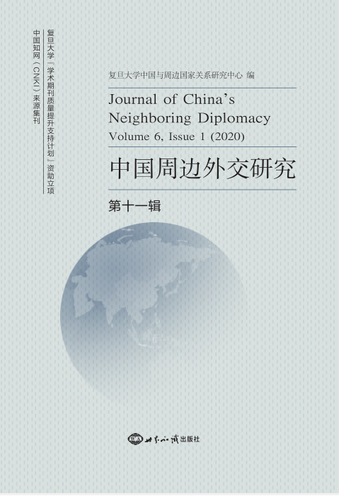Journal of China's Neighboring Diplomacy, Vol. 6, Issue 1 (2020)
|
|
The Title Page of Journal of China's Neighboring Diplomacy, Vol. 6, Issue 1 (2020) | The Back Cover of Journal of China's Neighboring Diplomacy, Vol. 6, Issue 1 (2020) |
Center for China's Relations with Neighboring Countries of Fudan University (CCRNC-Fudan), ed., Journal of China's Neighboring Diplomacy, Vol. 6, Issue 1, 2020.
Publisher: World Affairs Press (China)
Published in November 2021.
ISBN: 978-7-5012-6431-5
Contents
Editor’s Introduction...... Xue Song / 1
Research on the Belt and Road Initiative
Insights on Integration between the Belt and Road Initiative and Development Strategies of the Pivot Countries in Southeast Asia along the Belt and Road Initiative...... Qi Huaigao / 9
Indonesia’s Maritime Strategy and Maritime Economy...... Xue Song / 26
Indonesia-South Pacific Island Countries’ Trans-Regional Cooperation and the New Approach to the Construction of Southern Route of the 21st Century Maritime Silk Road...... Song Lingyu and Song Xiuju / 42
Research on Neighboring Countries
Infrastructure Investment and Its Characteristics of Japan’s ODA Diplomacy Towards Southeast Asia...... Bao Xiaqin and Li Wenyue / 67
Analysis on the Causes of Singapore’ s Balanced Foreign Policy after the Cold War from the Perspective of Balance of Threat Theory...... Yang Luhui and Yuan Shuzhen / 90
China’s Boundary and Ocean Affairs
Research on China-Philippine Joint Development in the South China Sea from the Perspective of Philippine Foreign Policy Decision-Making Model...... Dong Yi / 109
Views on the China-U.S. Rivalry in Southeast Asia
The Competitive Coexistence of China and America in Southeast Asia and Its Influence...... Qi Huaigao / 139
The Foreign Policy Adjustment of Southeast Asia under The Background of Sino-American Competition...... Xue Song / 147
Ensuring Balance between the Belt and Road Initiative and Indo-Pacific Strategy in Southeast Asia...... Lucio Blanco Pitlo III / 154
Defense Cooperation between China, the United States and Southeast Asia Countries against the Background of Strategic Competition Between Major Countries...... Liu Ruonan / 162
The Spillover Effect of Sino-American Strategic Competition on the Internal Affairs of Southeast Asian Countries...... Zhou Fangye / 168
US – China Trade Friction and Its Impact upon Vietnam’s Economy...... Van Hong Thi Ha / 173
Book Review
Masterpiece of the Study on China’s Neighboring Diplomacy: Reviewing Studies on the History of China’s Neighboring Diplomacy (1949-2019) ...... Yu Qun / 185
Reviews on Symposiums
Reviews on the 9th Symposium on China’s Neighboring Diplomacy...... Lu Ji / 199
Appendix
Introduction on Center for China’s Relations with Neighboring Countries of Fudan University (CCRNC-Fudan) ...... / 211
Call for Papers...... / 213
Guidelines for Manuscripts...... / 215
Insights on Integration between the Belt and Road Initiative and Development Strategies of the Pivot Countries in Southeast Asia along the Belt and Road Initiative
QI Huaigao
Abstract Southeast Asia is a significant sub-region along the Belt and Road Initiative (BRI), while Indonesia, with its central location in the Indian and Pacific oceans, can be considered as the pivot along the Belt and Road Initiative corridors. To promote the integration of BRI and Global Maritime Fulcrum, the two countries can deepen cooperation on infrastructure construction and the maritime industry. Besides, Malaysia, the most important country along the ancient Maritime Silk Route, can be regarded as a potential pivot along the BRI corridors. The integration of China and Malaysia’s development strategies can focus on three key areas: Malaysia-China Guandan Industrial Park, direct investment and railway infrastructure construction. Overall, there are three pieces of advice on the integration of China’s development strategies with the two vital countries, including promoting Indonesia and Malaysia as the hub of the Indo-Pacific Ocean, maintaining peace and stability in the South China Sea and defusing Japan and America’s resistance to the BRI.
Keywords the Belt and Road Initiative; Pivot Countries in Southern Asia along the Belt and Road; Malaysia; Indonesia; integration of strategies
Author Qi Huaigao, vice dean and researcher at Institute of International of Fudan University.
Official Citation: Qi Huaigao, Insights on Integration between the Belt and Road Initiative and Development Strategies of the Pivot Countries in Southeast Asia along the Belt and Road Initiative , Journal of China’s Neighboring Diplomacy, Vol. 6, Issue 1, 2020, pp. 9-25.
Indonesia’s Maritime Strategy and Maritime Economy
XUE Song
Abstract As the largest archipelagic country in the world, Indonesia enjoys abundant marine resources and great development potential. Indonesia guards the Strait of Malacca, and there are three busy international shipping lanes cross its territorial waters. Therefore, the ocean is the lifeblood of Indonesia’s security and prosperity, while Indonesia’s maritime security also has a direct impact on global trade and the flow of global strategic goods. In 2014, Indonesian President Joko Widodo proposed the Global Maritime Fulcrum. In 2017, after three years’ practice, Indonesia promulgated its first comprehensive maritime strategy and short-term action plan in history, which focused on the inter-island connectivity and aimed at the sustainable development of the Marine economy. The strategy provides institutional stability for the Global Maritime Fulcrum, but at the same time, it has shortcomings like unclear goals on national defense and maritime diplomacy, weak leadership of core lead agency, and the lack of new projects. This paper introduces three important development plans of Indonesia’s marine strategy, including marine highway program, marine tourism, exclusive economic zone. Besides, China’s BRI is similar to Indonesia’s Global Maritime Fulcrum in strategic direction. Therefore, based on consensus and the principle of reciprocity, this paper points out the direction of future cooperation on promoting industrial parks to exclusive economic zone or free trade areas and the interconnected development of ports.
Keywords maritime strategy; marine economy; Global Maritime Fulcrum; the Belt and Road Initiative; 21st Century Maritime Silk Road
Author Xue Song, assistant researcher of School of International Studies of Fudan University.
Official Citation: Xue Song, Indonesia’s Maritime Strategy and Maritime Economy, Journal of China’s Neighboring Diplomacy, Vol. 6, Issue 1, 2020, pp. 26-41.
Indonesia-South Pacific Island Countries’ TransRegional Cooperation and the New Approach to the Construction of Southern Route of the 21st Century Maritime Silk Road
SONG Lingyu and SONG Xiuju
Abstract The increasingly mature trans-regional cooperation between Indonesia and South Pacific Island Countries has enlightening significance for constructing the southern route of the 21st Century Maritime Silk Road. On the one hand, trans-regionalism spawned by geopolitical, historical, and cultural factors is the foundation of trans-regional cooperation between Indonesia and South Pacific Island Countries. In terms of politics, economy, and security, the close connection and mutual influence also provide the impetus for such cooperation. On the other hand, the trans-regional cooperation between Indonesia and South Pacific Island Countries relies on diversiform platforms and mechanisms. It is flexible and welltargeted, but also have limitations. Therefore, the construction of the southern route of the 21st Century Maritime Silk Road should adjust the existing international cooperation models and seek new paths for trans-regional cooperation.
Keywords Indonesia; south Pacific island countries; 21st Century Maritime Silk Road; trans-regional cooperation
Authors Song Lingyu, postgraduate student of School of Politics and International Studies of Central China Normal University. Song Xiuju, associate professor of School of Politics and International Studies of Central China Normal University, deputy director of Indonesian Studies of Central China Normal University.
Official Citation: Song Lingyu and Song Xiuju, Indonesia-South Pacific Island Countries’ TransRegional Cooperation and the New Approach to the Construction of Southern Route of the 21st Century Maritime Silk Road, Journal of China’s Neighboring Diplomacy, Vol. 6, Issue 1, 2020, pp. 42-64.
Infrastructure Investment and Its Characteristics of Japan’s ODA Diplomacy Towards Southeast Asia
BAO Xiaqin and LI Wenyue
Abstract The Japanese government has dramatically adjusted its ODA policies to Southeast Asia in recent years and infrastructure investment remains a top priority issue. Focusing on the texts of the ODA Charter and annual ODA White Paper under the Abe Administration, we find that the formulation and implementation of Quality Infrastructure Investment Partnership not only characterizes a combination of “quality” and “quantity”, but also shows Japan’s strategic objectives in the new geo-economic era. By further analyzing cases of Thailand and Myanmar, this paper investigates the achievements and limitations of Japan’s high-quality infrastructure investment in Southeast Asia. Given Asia’s increasing infrastructure needs, rather than continued vicious competitions, Sino-Japanese third-party market cooperation in Southeast Asia is likely to be the most promising way for governments to gain mutual benefits and achieve the long-term potential of the regional economy. There are complementary advantages in strengthening the capacity of financing, reducing investment risks, exchanging technology on high-speed rail, and speeding up the construction of overseas industrial zones that yield opportunities to promote the third-party market cooperation between China and Japan. The development of Sino-Japanese third-party market cooperation in Southeast Asia, however, is also challenged by geopolitical factors and America.
Keywords Official Development Assistance (ODA); quality infrastructure investment; Sino-Japanese Third-party Market Cooperation
Authors Bao Xiaqin, professor of School of International Relations and Public Affairs of Fudan University. Li Wenyue, Ph. D. candidate of the School of International Relations and Public Affairs of Fudan University.
Official Citation: Bao Xiaqin and Li Wenyue, Infrastructure Investment and Its Characteristics of Japan’s ODA Diplomacy Towards Southeast Asia, Journal of China’s Neighboring Diplomacy, Vol. 6, Issue 1, 2020, pp. 67-89.
Analysis on the Causes of Singapore’s Balanced Foreign Policy after the Cold War from the Perspective of Balance of Threat Theory
YANG Luhui and YUAN Shuzhen
Abstract The balanced foreign policy is Singapore’s unique diplomatic strategy, maintaining a dynamic balance in its relations with China, the United States, and Japan in Southeast Asia, helped Singapore won the opportunity for survival and development and exerted great political influence that is out of proportion with its status as a small state. After the Cold War, Singapore’s balanced foreign policy has been gaining matured with a growing pro-American bias. The evolution of Singapore’s balanced foreign policy can be divided into three stages, with features like self-interest, transforming politics with economy and well-targeted. What are the motivations for such a small state to pursue a balanced foreign policy? What are the reasons for its “unbalanced” pro-American bias? Based on the balance of threat theory, this paper interprets the basic reasons for conducting balanced foreign policy under the theoretical framework constructed by three variables: small state, power structure and threat perception.
Keywords balance of threat theory; balanced foreign policy; power structure; top decision makers’ threat perception
Authors Yang Luhui, professor and director of Institute of Asia Pacific, Shandong University. Yuan Shuzhen, postgraduate student of School of Political Science and Public Administration of Shandong University.
Official Citation: Yang Luhui and Yuan Shuzhen, Analysis on the Causes of Singapore’s Balanced Foreign Policy after the Cold War from the Perspective of Balance of Threat Theory, Journal of China’s Neighboring Diplomacy, Vol. 6, Issue 1, 2020, pp. 90-105.
Research on China-Philippine Joint Development in the South China Sea from the Perspective of Philippine Foreign Policy Decision-Making Model
DONG Yi
Abstract Reviewing the history, the joint development of the South China Sea between China and the Philippines filled with twists and turns. Historically, China has maintained a consistent and continuous diplomatic position on the joint development in the SCS, adhering to the principle “set aside dispute and pursue joint development”. Meanwhile, the Philippines’ policies on China-Philippine joint development in the SCS have been different during different presidential terms, which could be divided into three stages: attempt (2001–2010, Arroyo’s presidency), stagnation (2010–2016, Aquino III’s presidency) and restart (2016-present, Duterte’s presidency). To study the reasons why the Philippines has repeatedly swayed its position, this paper establishes an analytical framework of the Presidential Foreign Policy Decision-Making Model, in which the president is the main decisionmaker, and domestic political mechanisms, political family and interest groups (military groups and energy interest groups) are the three main factors that affect the president’s decision. Based on the analysis factors provided by the foreign policy decision-making model, this paper makes a detailed analysis of the three presidents’ decision-making process on China-Philippine joint development in the SCS, exploring why different presidents made different policies. This paper holds that foreign policymaking in the Philippines is highly personalized and informal. In the case where the president enjoys a high degree of political legitimacy, other factors have fewer restrictions on the president’s foreign policymaking. This paper also makes a predictive analysis, arguing that during Duterte’s tenure, the progress of China-Philippine joint development in the SCS will maintain the current good momentum.
Keywords China-Philippine joint development in the South China Sea; foreign policymaking; presidential foreign policy decision-making model
Author Dong Yi, postgraduate student of the School of International Relations and Public Affairs of Fudan University.
Official Citation: Dong Yi, Research on China-Philippine Joint Development in the South China Sea from the Perspective of Philippine Foreign Policy Decision-Making Model, Journal of China’s Neighboring Diplomacy, Vol. 6, Issue 1, 2020, pp. 109-135.








